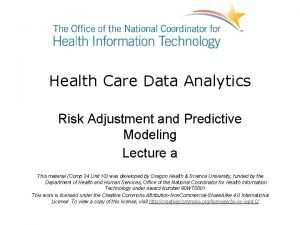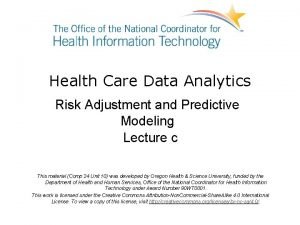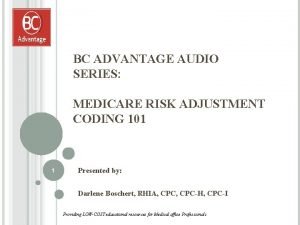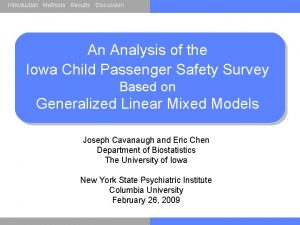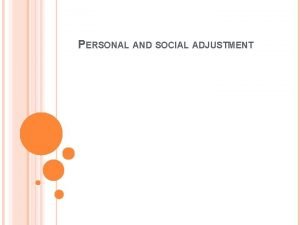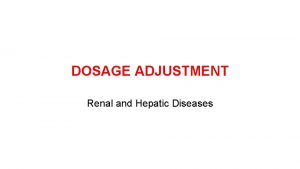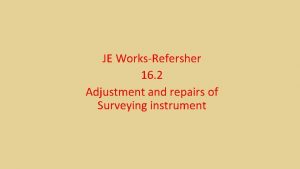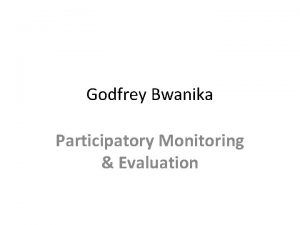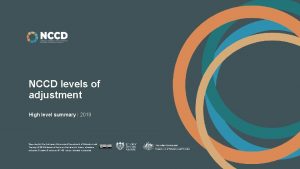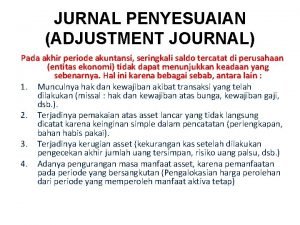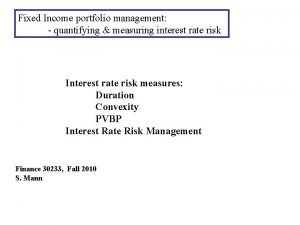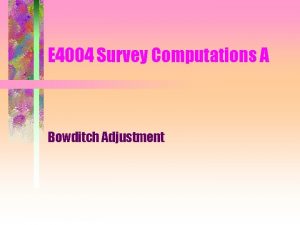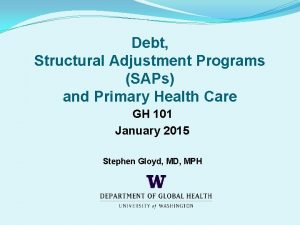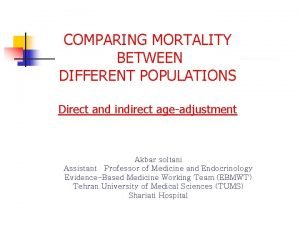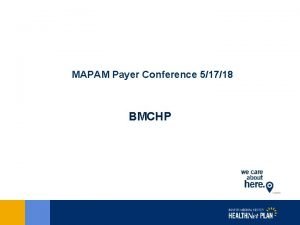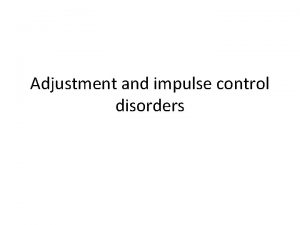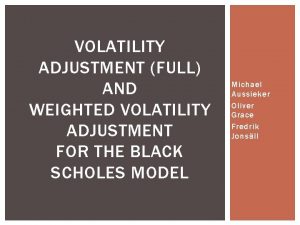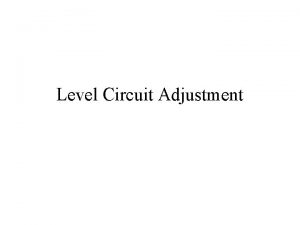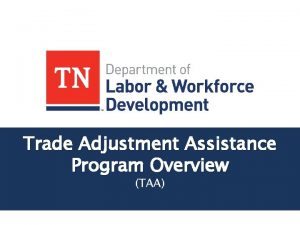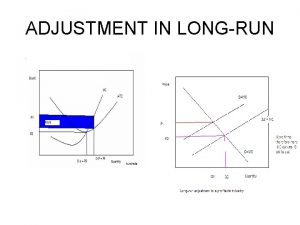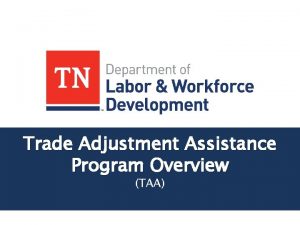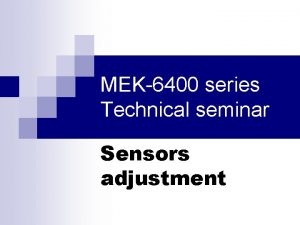RISK ADJUSTMENT CONCEPTS AN INTRODUCTION AND DISCUSSION MAPAM























































- Slides: 55

RISK ADJUSTMENT CONCEPTS AN INTRODUCTION AND DISCUSSION MAPAM March 16, 2017

AGENDA • Risk Adjustment • How Risk Adjustment Works • Risk Adjustment Factor (RAF) Scoring Process • Comprehensive Annual Visits • Predictive Modeling & Quality of Care • Risk Adjustment Data Validation (RADV) Audit Process • The Future of Risk Adjustment 2

THE WHO, WHAT, WHY, HOW AND WHEN OF RISK ADJUSTMENT • WHO is subject to risk adjustment – Health Plans…Medicare Advantage Plans, Health Insurance Exchanges, others – Hospitals, Physician Practices • WHAT does it do – Redistributes funds from plans with lower-risk enrollees to plans with higher-risk enrollees • WHY does it do it – To protect against adverse selection and risk selection § § Adverse-only sicker patients get insurance coverage Risk-Insurers try to make products unattractive to sicker patients with expensive health conditions • HOW does it do it – Actuarial risk based on enrollees’ individual risk scores…lower risk equates to lower payments • WHEN did this happen – For Medicare Advantage, way back in 1997. – For the health insurance exchanges, mandated by the ACA, in 2014 going forward

WHAT IS RISK ADJUSTMENT? • A prospective payment methodology utilizing: – Prior year diagnoses to predict future costs – The premise that the average risk score is 1. 0 • A methodology to adjust payment to health plans based on: – Certain demographics § Age, gender, socioeconomic status, disability status, insurance status – Actual health status of an enrollee § Diagnosis code(s) § Place of service code § Patient-specific conditions o Community, Institutional, ESRD 4

WHY IS RISK ADJUSTMENT IMPORTANT? Complete and accurate reporting allows providers to: – Improve the overall patient healthcare evaluation process – Improve communication with a patient’s healthcare team – Identify the composite picture of a patient’s health status – Reinforce self-care and prevention strategies – Coordinate care in a collaborative manner – Avoid potential drug-drug/disease interactions 5

WHY IS RISK ADJUSTMENT IMPORTANT? – Meet required CMS obligations which include § Use all diagnosis coding guidelines/standards in medical record documentation § Report all conditions and diagnosis codes that exist on the date of an encounter § Participate in CMS Medicare Recovery Audit Contractor (RAC) and Risk Adjustment Data Validation (RADV) Audits. 6

TYPES OF RISK ADJUSTMENT MODELS • Diagnosis based programs – CMS-HCC Medicare – HHS-HCC Commercial, Individual and Small Group – CDPS Medicaid – DRG/ACG Inpatient and Outpatient – Other • Prescription based programs – Medicaid RX Medicaid – RXGroups Commercial – HCC-D Medicare 7

HOW DOES IT WORK? CMS $ Medicare Advantage Organization $ FERAS RAPS EDS Claims Diagnos es Medical Records Providers, Facilities, Coders, CDI 8

DATA ELEMENTS THAT MUST BE SUBMITTED • Three acceptable physician/provider types – Hospital inpatient – Hospital outpatient – Physician services • MAOs must collect 5 data elements from acceptable sources – Health insurance claim number – Provider type – From date of service – Through date of service – Diagnosis code(s) 9

ACCEPTABLE PHYSICIAN SPECIALTIES 10

GENERAL CHARACTERISTICS OF RISK ADJUSTMENT MODELS • Selected Significant Disease (SSD) Model – Serious manifestations of a disease are considered • Prospective • Site Neutral • Diagnostic Sources • Multiple Chronic Diseases considered • Disease Interactions and Hierarchies Included • Demographic Variables 11

COMMON CHARACTERISTICS OF RISK ADJUSTMENT MODELS The final result, no matter what risk adjustment model is used and no matter the individual scoring process: – An overall risk score is calculated for each and every patient, and; – Final risk scores are always affected by known diagnoses § Diagnosis codes carry value and are generally cumulative – Risk scores can be grouped by patient population or together to identify the risk of an entire health plan – Inaccurate risk scores from over/under coding can have dramatic financial impacts § On a health plan’s payments § On a provider’s payments § On the ability to adequately care for patients with certain conditions 12

CMS-HCCS (USING DIABETES AS AN EXAMPLE) • All ICD-10 -CM codes map to a Diagnostic Group (Dx. G) – Each Dx. G is a specified medical condition or set of conditions § Ex. Type 2 DM with Diabetic Nephropathy – Dx. Gs combine into Condition Categories (CCs), which describe a broader set of similar, clinically related diseases, with similar treatment/management cost § Ex. Type I DM with Acute Complications § CC would also include Type II and Secondary DM with hyperosmolarity, ketoacidosis or coma – Hierarchies imposed with related CCs, thus HCCs § Diabetes with Acute Complications-HCC 17 § Diabetes with Chronic Complications-HCC 18 § Diabetes without Complications-HCC 19 13

DISEASE HIERARCHIES Some HCCs will “trump” others so that if a patient has more than one HCC within a category……. . Continuing on with Diabetes…… – Diabetes HCCs § Diabetes with Acute Complications-HCC 17 § Diabetes with Chronic Complications-HCC 18 § Diabetes without Complications-HCC 19 HCC If the Disease Group is Listed in this Column… 17 Diabetes with Acute Complications 18 Diabetes with Chronic Complications Then drop the Disease Group listed in this column 18, 19 19 14

DISEASE INTERACTIONS Some diseases “interact” with each other, causing an increase in care management and a corresponding additional risk factor. As an example: • Congestive Heart Failure combined with Diabetes – When these two diagnoses are reported on the same patient, an additional risk factor is recorded. – 2017 Ratebook Risk Factors § CHF HCC 85. 323 § Diabetes, chronic complications HCC 18. 318 § Disease Interaction of CHF and Diabetes. 154 15

HIGH LEVEL EXAMPLE OF A CMS PAYMENT TO A PLAN No Diagnoses Reported Some Diagnoses Reported All Diagnoses Reported 68 year old male . 300 Dual eligible . 192 Type 2 DM, not coded Type 2 DM, no complications . 097 Type 2 DM with other skin ulcer . 346 Congestive Heart Failure, not coded Congestive Heart Failure, coded . 355 Disease interaction (DM+CHF) . 205 Risk Adjustment Factor . 492 . 589 1. 398 PMPM base payment $814 PMPM for this patient $401 PMPM for this patient $479 PMPM for this patient $1, 138 Annual payment $4, 806 Annual payment $5, 753 Annual payment $13, 656 16

IS IT REALLY THAT EASY? • In our previous example, we had the age, sex, originally disabled demographics – Relative factors associated with specific patient demographics • We also had the disease hierarchical condition categories (HCCs) and disease interactions – Relative factors associated with each HCC These are all summed together and are referred to as the raw risk score

NOW LET’S ADD IN THE REST OF WHAT REALLY HAPPENS Starting with the raw risk score… • Continued blending of encounter data and FFS diagnosis risk scores and RAPS and FFS diagnoses – Phase-in to 100% encounter data by 2020 – For PY 2017, 25% encounter data and 75% RAPS • Normalization Factor – Applied to keep the average FFS risk score at 1. 0 – For PY 2017, CMS-HCC Normalization Factor is. 998 • MA Coding Pattern Adjusted Score – Applied to adjust for the difference in coding patterns between MA and FFS – For PY 2017, adjustment is 5. 66%

EXAMPLE OF A RAW RISK SCORE CALCULATION In Plan Year 2017 (Calendar Year), there is a continued blending of risk scores as part of the payment process. The risk score will be calculated by blending: • 25% from encounter data and 75% from RAPS data Demographics RAPS and FFS EDS and FFS Male, Age 76, Community, Non Dual Aged . 466 Type 2 DM, without complications (E 11. 9) . 097 - COPD, unspecified (J 44. 9) . 328 Total Raw Risk Score . 891 . 794

PY 2017 RISK SCORE CALCULATION Demographics RAPS and FFS EDS and FFS Total Raw Risk Score . 891 . 794 Normalization Factor . 891 /. 998 =. 893 . 794 /. 998 =. 796 . 893 x (1 -. 0566)=. 842 . 796 x (1 -. 0566) =. 749 . 842 x. 75=. 631 . 749 x. 25=. 187 Coding Differences Blending Payment Risk Score . 631 +. 187 =. 818

CAPTURE THE CHRONIC CONDITIONS! • The slate is wiped clean on January 1 EVERY YEAR – Amputations grow back! – COPD patients have healthy lungs! – Diabetes patients have superb pancreases! – All kidneys function flawlessly! – Colostomy patients have a perfect colon! – Get the picture? IF YOU DON’T DOCUMENT AND CODE THE CONDITION, YOU LOSE! 21

HOW CAN YOU HELP ENSURE IDENTIFICATION OF CHRONIC CONDITIONS? Through Comprehensive Annual Visits – Sometimes called comprehensive physical exams – Medicare COVERS these under MA Plans And not to be confused with the Medicare Annual Wellness Visit – Provides personalized prevention plan services through a health risk assessment – Medicare COVERS these under both FFS and MA Plans 22

COMPREHENSIVE ANNUAL VISITS • Once a year process to evaluate, document and submit all relevant diagnoses – Promotes quality of patient care – Ensures screening tests are performed – Assesses chronic conditions on an ongoing basis – Allows for accurate risk score calculations – Important if chosen for data validation audits 23

COMPREHENSIVE ANNUAL VISITS Why are these taking on such importance? They are a perfect opportunity to diagnose and capture all chronic illnesses at least once each calendar year So Medicare pays the MA Plan for these…“what’s in it for me? ” 24

COMPREHENSIVE ANNUAL VISITS • Some plans are offering incentives/supplemental payments to physicians to ensure these are completed annually – Capture twice, not just once • Some plans provide “pick lists” showing prior diagnoses of chronic conditions that a patient has been treated for • Some plans provide templates or other lists of chronic conditions to help ensure their capture 25

So in addition to what is documented and coded, how else can chronic conditions/comorbidities potentially be captured? 26

PREDICTIVE MODELING • Hypothesis – Educated guess related to the future needs of a patient or patient group • Suspect Logic – An attempt to uncover diagnoses which are likely present but are unreported, underreported or unknown • Chart Reviews – Retrospective reviews to determine if there any unreported or underreported diagnoses 27

SUSPECT LOGIC • Patient status/Socioeconomic status – Disabled status? In Hospice? ESRD status? Patient Demographics? • DME use – A wheelchair? A prosthetic? • Prescription use – What medications are prescribed? • Laboratory tests – What are the results? • CPT/HCPCS codes reported – Cystoscopy? Placement of a shunt? Creation of an arteriovenous fistula? 28

SUSPECT LOGIC • Suspect logic often used by CDI as outpatient programs are implemented • It can be used as a basis for queries 29

PREDICTIVE MODELING HCC EXAMPLES 1. A prescription for insulin is noted but there is no diagnosis of diabetes. 2. A CPT code for creation of an AV fistula is present but there is no diagnosis of ESRD. 3. There is a diagnosis of unspecified diabetes and evidence the patient sees an ophthalmologist quarterly for retinopathy. 4. There is documentation of a prosthetic but no corresponding amputation. 30

WHAT HAPPENS IF INCONSISTENCIES ARE IDENTIFIED? • A retrospective medical record review may be warranted. – Can a more specific code be chosen? – CAUTION-Coders must only code for diagnoses supported in the documentation by the treating provider. 31

THE ALTRUISTIC SIDE OF THINGS • The more that is known about a patient, the better the plan for needed or future care. • Reporting the delivery of quality care is paramount as the healthcare evolution continues. • Disease management programs can be better initiated. Which leads us to………. 32

QUALITY OF CARE AND QUALITY REPORTING • The ACA mandated bonus payments to MA health plans based on their individual rating in a 5 star quality rating system – 5 stars = excellent performance – 4 stars = above average performance – 3 stars = average performance – 2 stars = below average performance – 1 star = poor performance Beginning in 2016, 4 or more stars get a bonus. 3 stars or less get none. This is reflected in the base rate used by health plans. 33

MA PART C PLAN QUALITY MEASURES FOR 2016 Domain Description # of Measures 1 Staying Healthy-Screening, Tests and Vaccines 7 2 Managing Chronic Conditions 12 3 Member Experience with Health Plan 6 4 Member Complaints, Problems Getting Services and Improvement in the Health Plan’s Performance 4 5 Health Plan Customer Service 3 34

HEDIS REPORTING Healthcare Effectiveness Data and Information Set (HEDIS) • Widely used set of measures in managed care • Maintained by NCQA • Designed to compare performances between health plans • HEDIS reporting is mandated by CMS for MA plans 35

HEDIS MEASURES (2017) Domain Description # of Measures* 1 Effectiveness of Care 53 2 Access/Availability of Care 6 3 Experience of Care 4 4 Utilization and Risk Adjusted Utilization 17 5 Relative Resource Use 6 6 Health Plan Descriptive Information 7 7 Use of Electronic Clinical Data Systems 2 *represents the total # of measures by category. These vary depending on type of plan 36

HEDIS MEASURES AND PHYSICIANS • Aggregated HEDIS rates are used to evaluate health insurance companies’ efforts to improve preventive health outreach for members. • Physician-specific scores are used to measure a practice’s preventive care efforts. • A practice’s HEDIS score may determine the rates for physician incentive programs such as Pay For Performance or Quality Bonus Funds, so be sure to: – Submit claim/encounter data for each and every service rendered – Ensure chart documentation supports all billed services – Bill (or report by encounter submission) for all delivered services, regardless of contract status – Ensure that all claim/encounter data is submitted accurately and timely – Consider including procedure codes to provide additional details and reduce medical record requests 37

MACRA, MIPS AND PHYSICIANS • The Medicare Access and CHIP Reauthorization Act (MACRA) may change how Medicare pays physicians and other healthcare providers – Replaces the SGR with adjustments and incentives for providers who participate in pay for performance and alternative payment models – 2015 -2019 -annual fee schedule update of. 5% – 2019 -base rate holds steady § Supplemented by participation in Merit-Based Incentive Payment System (MIPS) and Alternative Payment Models (APM) o APM 5% lump sum available 2019 -2024 o MIPS increase of +/- 4% in 2019 to +/- 9% beginning in 2022 and forward o First collection period for MIPS began January 1, 2017 – 2026 -annual fee schedule updates resume at. 25% § APM participants are eligible for. 75% 38

MIPS • Composite performance score based on four categories 1. Quality (similar to PQRS and VM) 2. Resource Use (cost) 3. Clinical Practice Improvement Activities 4. Meaningful Use of Certified EHR Technology 30% 15% 25% NOTE: There is a risk adjusted component to the resource use category. 39

And as if quality measures weren’t enough……. 40

CMS RISK ADJUSTMENT DATA VALIDATION AUDITS What are CMS Risk Adjustment Data Validation (RADV) Audits? • Applicable to Medicare Advantage Plans • CMS annual audits that ensure the integrity and accuracy of risk-adjusted payment • An audit that verifies diagnosis codes submitted by MA plans are appropriately supported by medical record documentation • MA plans may be selected for RADV Audits annually, and if selected: – Plans must submit medical records to validate reported diagnoses 41

CMS RADV AUDITS Why should providers care about these? • It is the provider’s documentation that is being audited, • It is the diagnosis codes that have been submitted that are audited, and……. • Providers are required to assist MA plans when chosen for a RADV audit –The more complete the medical records, the less issues –The better the documentation, the better the outcome 42

HOW DOES IT WORK? • CMS decides which plans to audit and which patients will be included in the audit • Health plans may submit up to five (5) best records supporting HCC values that were paid –If there is a dispute and/or appeal, though, the “one best medical record” is what applies • Supplemental diagnoses are allowed • Submission of diagnoses is cumulative, so there can be a positive or negative financial outcome • There is a dispute/appeal process 43

HOW DOES IT WORK? • Once the audit is complete, an error rate is calculated and extrapolated over the entire population for the MA Plan, not just on a patient by patient basis • Simplified Example: – 10, 000 members in MA plan with annual reimbursement of $50, 000 –RADV audit identifies an overpayment rate of $250 or 5% on ONE patient –The repayment to Medicare IS NOT $250 –The repayment IS $2, 500, 000 44

TWO MAIN TYPES OF CMS RADV AUDITS • National RADV Audit – Random selection of MA plans – Stratified sample methodology § High, medium and low risk patients based on HCC scores • Targeted RADV Audit – Plans with higher risk scores when compared to FFS – Targeted plans/contracts with problematic past findings 45

WHAT IS THE CMS RADV AUDIT LOOKING FOR? CMS provides a checklist for the following general guidelines: 1. Is the record for the correct enrollee? 2. Is the record for the correct calendar year for the payment year being audited? 3. Is the date of service present for the face to face visit? 4. Is the record legible? 5. Is the record from a valid provider type? 6. Are there valid credentials and/or is there a valid physician specialty documented on the record? 7. Does the record contain a signature from an acceptable type of physician specialist? 8. If the outpatient/physician record doesn’t contain a valid credential and/or signature, is there a completed CMS-Generated Attestation for this date of service? 9. Is there a diagnosis on the record? 10. Does the diagnosis support an HCC? 11. Does the diagnosis support the requested HCC? 46

ANOTHER TYPE OF RADV AUDIT • HHS RADV (HRADV) audits applicable to qualified commercial health plans in the Health Exchange (HIX) • HHS/CMS identifies a similar sample of patients but only from claims from the Edge server (HIX required server for sharing data) • Identified diagnoses are tied to an active claim that was submitted • Annual audits are a requirement • Sample size is generally 200 enrollees per issuer per state – 20% will have one or more HCCs – 80% will have no HCC • Stratified sampling – 10 audit strata –High, medium and low for adults, children and infants, and –No HCCs 47

CMS RADV VS. HHS HRADV DIFFERENCES CMS RADV HHS HRADV Approximately 30 plans annually All participating plans 2 -3 years post payment 6 months post payment 3 strata 10 strata Any face-to-face encounter by an approved provider can be used as support Only dates of service submitted on the Edge server can be used as support Up to five (5) best records to support an HCC As many DOS submissions as the Plan wants, as long as they were submitted on the Edge server 48

LET’S SUMMARIZE 49

RISK ADJUSTMENT IS NOT NEW Some form of Risk Adjustment has been around since 1997. BUT… With the arrival of the Affordable Care Act in 2010, there is an increased awareness, because… All of the health insurance exchanges require a risk adjustment component for payment. Hence, the increased interest. And then… • ACOs and APMs • MACRA and the MIPS • And so on……. 50

THE STAKES ARE GETTING HIGHER • Organizations are under increasing pressure to get it right – Accurate reporting of patient risk scores is paramount – OIG Work Plan focus – RAC focus • Transition from RAPS to EDS – The final transition to 100% EDS is 2020 § Expected to be a much stricter “filter” than what is being used today § Industry experts believe as much as a 3. 5% risk score negative impact for some plans § Expected to eliminate RAPS submissions completely 51

ENCOUNTER DATA SYSTEM (EDS) • Plans will likely transition their focus to encounter data as payment transition evolves – Complete and accurate submissions – Vendor edits – Claim edits Year EDS RAPS 2016 10% 90% 2017 25% 75% 2018* 50% 2019 75% 2020 100% - *The 2018 advance notice released on February 1, 2017 proposes to hold the transition in 2018 to 25%/75% 52

SHIFTING FOCUS –Under FFS, diagnoses have little meaning related to reimbursement § Payment is driven by level of E&M code § A diagnosis is included to confirm the medical necessity of services rendered § Higher E&M codes mean a more complex encounter with higher level of medical decision making and increased reimbursement –Not so in the risk adjustment world where the diagnosis drives reimbursement § No real significance related to CPT codes in risk adjustment (at least not currently) o. Moving away from physician specialty to CPT code driven § Diagnosis codes establish the complexity of the patient’s health status, medical decision making and ultimately, the reimbursement 53

WHAT’S IN THE FUTURE? The Crystal Ball tells us… • • • Increased use of risk adjustment methodologies at the payer level Increased risk adjusted contracts with providers Risk adjustment refinements at ACO and other APMs Introduction of MIPS (and first data collection period is FFY 2017) for providers Implementation of OP CDI programs STAY TUNED……. . 54

QUESTIONS? THANK YOU! JANET HODGDON, DIRECTOR, CPA, CPC, CRC JHODGDON@BNNCPA. COM 207. 791. 7508
 Market risk credit risk operational risk
Market risk credit risk operational risk Health care risk adjustment and predictive modeling
Health care risk adjustment and predictive modeling Predictive analytics risk adjustment healthcare examples
Predictive analytics risk adjustment healthcare examples Simple distillation
Simple distillation Medicare advantage risk adjustment 101
Medicare advantage risk adjustment 101 Introduction method result and discussion
Introduction method result and discussion Residual risk and secondary risk pmp
Residual risk and secondary risk pmp Business risk and financial risk leverage
Business risk and financial risk leverage Relative risk and attributable risk
Relative risk and attributable risk Population attributable risk
Population attributable risk Introduction and basic concepts of thermodynamics
Introduction and basic concepts of thermodynamics Thermodynamics introduction and basic concepts
Thermodynamics introduction and basic concepts Introduction to statistics and some basic concepts
Introduction to statistics and some basic concepts Introduction to transaction processing concepts and theory
Introduction to transaction processing concepts and theory Introduction and mathematical concepts
Introduction and mathematical concepts Introduction and mathematical concepts
Introduction and mathematical concepts Transaction processing in dbms
Transaction processing in dbms What is risk projection in software engineering
What is risk projection in software engineering Risk reduction vs risk avoidance
Risk reduction vs risk avoidance Relative risk calculation
Relative risk calculation Inherent risk vs control risk
Inherent risk vs control risk Absolute risk vs relative risk
Absolute risk vs relative risk The stock market game activity sheet 2 answers
The stock market game activity sheet 2 answers Short term risk
Short term risk Pembelanjaan resiko
Pembelanjaan resiko The biggest risk is not taking any risk
The biggest risk is not taking any risk Key risk indicators template
Key risk indicators template Business risk audit
Business risk audit Risk map risk management
Risk map risk management Introduction to marketing concepts
Introduction to marketing concepts Scratch programming concepts
Scratch programming concepts Introduction to risk and return
Introduction to risk and return Personal adjustment
Personal adjustment Barnewall two way model
Barnewall two way model Demobilization and adjustment to peace 1920
Demobilization and adjustment to peace 1920 Dose adjustment in renal and hepatic disease
Dose adjustment in renal and hepatic disease Permanent adjustment of level
Permanent adjustment of level Smepa deped
Smepa deped What is financial risk 1
What is financial risk 1 Chapter 25 introduction to risk management
Chapter 25 introduction to risk management Chapter 21 introduction to risk management
Chapter 21 introduction to risk management Introduction to project risk management
Introduction to project risk management Temporary adjustment in levelling
Temporary adjustment in levelling Locke-wallace relationship adjustment test
Locke-wallace relationship adjustment test High level summary
High level summary Liquidity adjustment facility
Liquidity adjustment facility Eye piece function
Eye piece function Adjustment akuntansi
Adjustment akuntansi Pisanje cva
Pisanje cva Valplast adjustment burs
Valplast adjustment burs What is pvbp
What is pvbp Bowditch correction
Bowditch correction Structural adjustment programs
Structural adjustment programs Convexity adjustment formula
Convexity adjustment formula Indirect age adjustment
Indirect age adjustment Effort
Effort

